Chinese New Year Decorations
What Are the Rules for Orthodox Icons?
We've all heard the saying 'rules are made to be broken,' but when it comes to Orthodox icons, the rules are not just guidelines; they are deeply rooted in tradition and theology.
From the symbolic use of color to the strict guidelines for depicting holy figures, the world of Orthodox iconography is a fascinating and complex one.
But what exactly are these rules, and how do they shape the creation and restoration of these sacred images?
Let's unravel the intricacies of Orthodox icon rules and discover the profound significance behind each brushstroke and color choice.
Key Takeaways
- Canonical guidelines dictate the specific materials and techniques used in creating Orthodox icons
- Different cultural contexts within the Orthodox Church can result in variations in iconographic styles and depictions
- Traditional pigments such as ochre, cinnabar, and lapis lazuli are used to achieve richness and luminosity in icon painting
- Icon conservation and restoration follow strict guidelines to preserve the sacred artworks
Historical Background
The historical background of Orthodox icons dates back to the early centuries of Christianity, playing a significant role in the development of religious art. Iconography history is rich and diverse, reflecting the beliefs and practices of the early Christian communities. These icons hold immense religious significance, serving as windows to the divine and as aids to meditation and prayer. They weren't mere decorations, but rather an integral part of the spiritual life of the faithful.
The use of icons became particularly prominent during the Byzantine Empire, where they were venerated in homes, churches, and public spaces. The images depicted on these icons weren't just artistic representations but were imbued with deep theological meaning, conveying the stories of the Bible and the lives of the saints. These visual representations played a crucial role in teaching the faith to the largely illiterate population of the time, making the stories and lessons of Christianity accessible to all.
Understanding the historical background of Orthodox icons provides insight into their enduring significance and the profound impact they've had on the spiritual lives of believers throughout the centuries.
Iconography in Worship
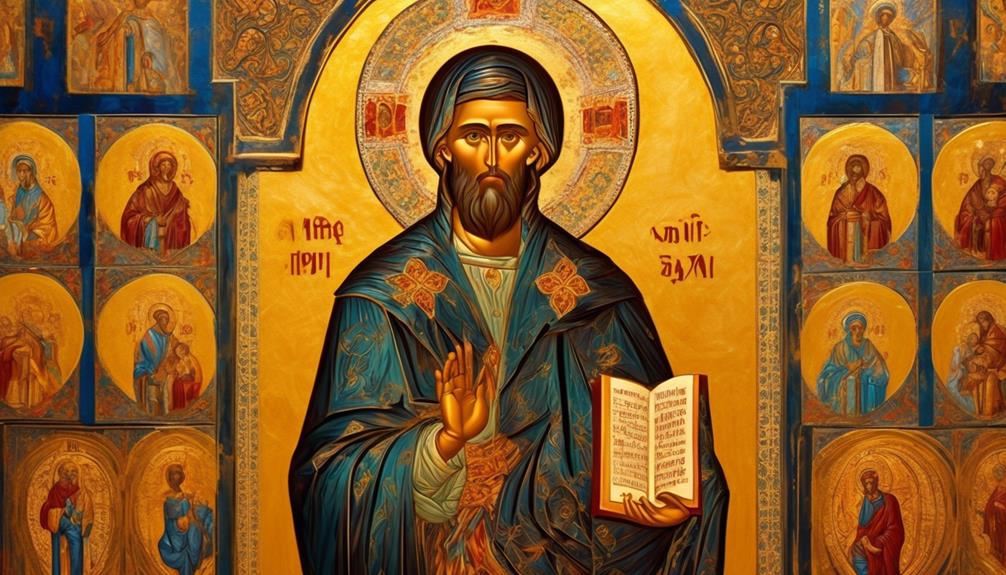
With the historical background of Orthodox icons in mind, let's explore their integral role in worship through iconography.
- Religious Significance and Artistic Expression
Orthodox icons hold immense religious significance, serving as windows to the divine and aids for contemplative prayer. The intricate details and use of specific colors convey theological truths, evoking a sense of reverence and awe during worship. Through the skillful hands of iconographers, these sacred images become a form of artistic expression that communicates the mysteries of the faith.
- Cultural Influence and Modern Interpretations
Iconography has deeply influenced the cultural and artistic traditions of Orthodox communities, shaping their visual language and spiritual practices. In modern times, the interpretation of iconography has expanded to include various styles and mediums, allowing for contemporary expressions of faith while maintaining the essence of the tradition. This fusion of tradition and innovation continues to enrich the worship experience, bridging the gap between ancient wisdom and the present day.
The integration of religious significance, artistic expression, cultural influence, and modern interpretations within Orthodox iconography reflects the dynamic nature of worship and spirituality.
Symbolism and Meaning
Exploring the symbolism and meaning behind Orthodox icons reveals a rich tapestry of spiritual significance and historical context. The symbolism depicted in Orthodox icons is deeply rooted in the teachings and traditions of the Orthodox Christian faith. Each element, color, and gesture in an icon carries profound meaning and serves as a visual representation of theological truths. The interpretations of these symbols often vary, adding layers of complexity and depth to the understanding of the faith.
The interpretation of Orthodox iconography has been a subject of controversy throughout history, with debates arising over the appropriateness of certain depictions and the theological implications of various symbols. Despite these controversies, the symbolic language of Orthodox icons remains a powerful and cherished aspect of the faith, offering believers a visual means of connecting with the divine and understanding the mysteries of the Christian tradition.
The meaning behind Orthodox icons extends beyond mere representation; it serves as a gateway to spiritual contemplation and a means of encountering the divine. The richness of symbolism in Orthodox icons invites believers to explore the depths of their faith and find profound spiritual truths in the visual imagery that has been passed down through generations.
The Role of Color
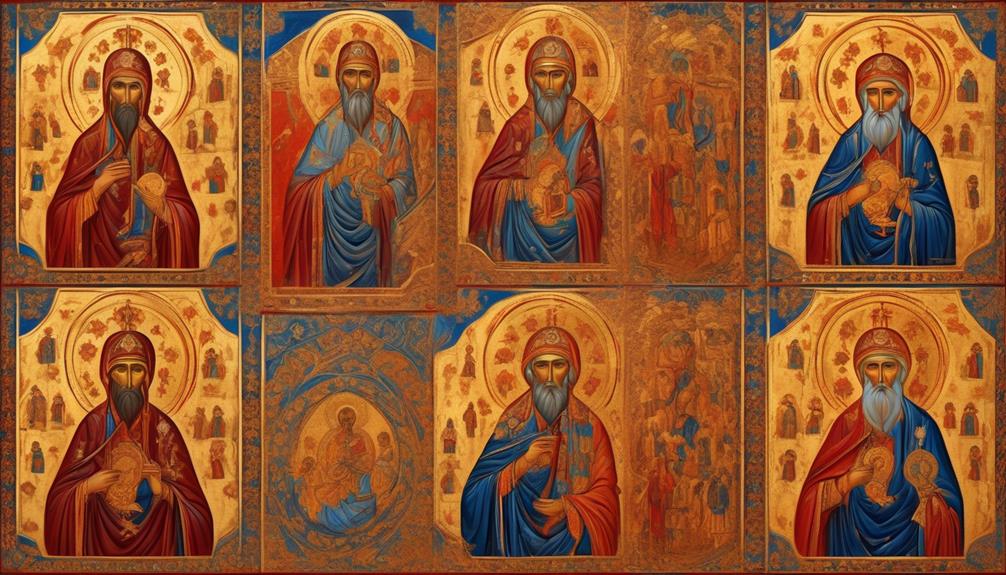
Color plays a significant role in Orthodox icons, conveying profound symbolism and spiritual meaning. In iconography, each color used has specific symbolism and significance, adding depth and layers of interpretation to the visual representation of religious figures and scenes.
Some key points to consider about the role of color in Orthodox icons include:
- Color Symbolism
Colors in Orthodox icons are symbolic and hold spiritual significance. For example, gold represents the divine and the heavenly realm, while blue signifies the human and earthly. Understanding these symbolic meanings enhances the viewer's connection to the spiritual message conveyed in the icon.
- Icon Painting Techniques
Iconographers use specific techniques to apply color, such as layering translucent colors to achieve a sense of depth and luminosity. This meticulous approach is integral to capturing the spiritual essence of the subjects depicted in the icons.
Depiction of Holy Figures
The symbolic use of color in Orthodox icons extends to the depiction of holy figures, where each aspect of their portrayal holds profound spiritual significance. The depiction rules for holy figures in Orthodox icons are deeply rooted in tradition and religious significance. Every detail, from the posture of the figure to their facial expressions, is carefully crafted to convey theological truths and spiritual realities. The figures aren't meant to be realistic representations, but rather convey a sense of transcendence and divine presence. For example, the elongation of the fingers of holy figures symbolizes their otherworldly nature and their connection to the spiritual realm.
The religious significance of these depiction rules is to foster a sense of reverence and awe in the viewer, reminding them of the divine nature of the figures being depicted. The use of symbolism in the portrayal of holy figures serves as a visual language that communicates profound theological truths and invites the viewer into a deeper spiritual contemplation. Each element of the depiction is laden with meaning, encouraging the faithful to engage in a profound spiritual reflection.
Canonical Rules
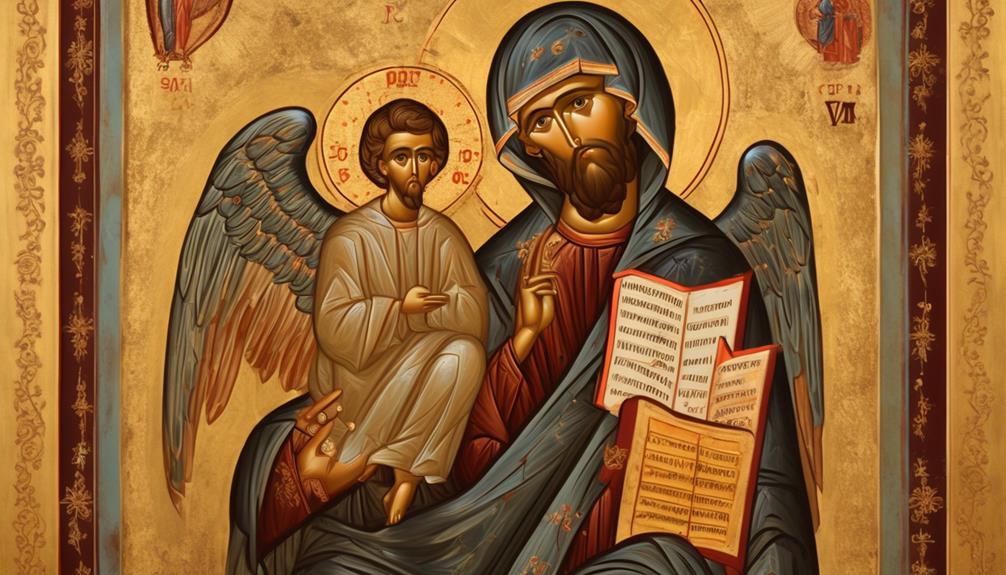
Canonical rules govern the specific requirements for the creation and veneration of Orthodox icons, ensuring their adherence to established religious standards and traditions. When considering canonical guidelines, it's important to recognize that these rules aren't uniform across all Orthodox traditions. The cultural variations within the Orthodox Church can influence the specific requirements for creating and displaying icons.
Here are some key points to consider:
- Canonical Guidelines
Canonical rules dictate the specific materials and techniques that should be used in creating Orthodox icons. These guidelines often emphasize the use of natural materials and traditional methods to maintain the sacred nature of the icons.
- Cultural Variations
Different cultural contexts within the Orthodox Church may result in variations in iconographic styles and depictions. For example, icons from the Greek Orthodox tradition may differ in style and symbolism from those in the Russian Orthodox tradition, reflecting the cultural nuances of each community.
Understanding the canonical rules and cultural variations surrounding Orthodox icons provides insight into the rich diversity and sacred significance of these religious artworks.
Techniques and Materials
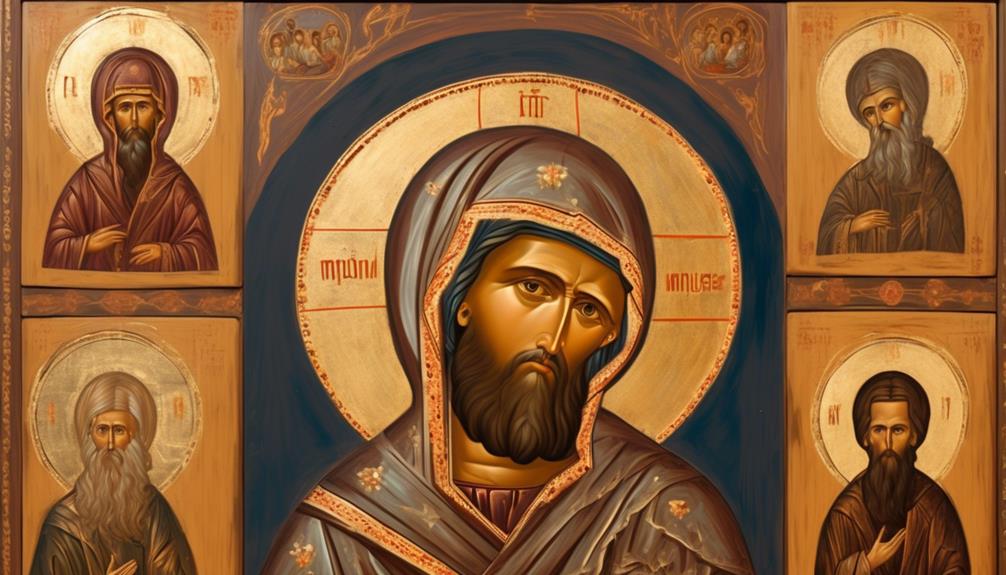
When we paint Orthodox icons, we use specific techniques and traditional materials to ensure the proper representation of sacred figures and scenes. These techniques and materials have been passed down through generations and hold deep symbolic significance within the Orthodox tradition.
Understanding the symbolism in icons allows us to convey the spiritual message and theological truths through our art.
Icon Painting Techniques
To achieve the distinctive style of Orthodox icons, artists employ specific painting techniques and carefully selected materials.
When it comes to icon painting techniques, we focus on brush strokes and color blending to create the unique visual language of icons. Brush strokes are deliberate and precise, conveying a sense of spiritual depth and symbolism.
Color blending is done meticulously, often using traditional pigments to achieve the desired richness and luminosity.
When working on iconic subjects, intricate details are essential for capturing the spiritual essence and narrative of the figure depicted. This attention to detail is what gives Orthodox icons their timeless and sacred quality, inviting the viewer into a deeper contemplation of the divine.
Traditional Materials Used
Using natural pigments and traditional gilding techniques, we create Orthodox icons with a timeless and sacred quality. Traditional pigments such as ochre, cinnabar, and lapis lazuli are meticulously sourced and prepared to ensure authenticity and longevity.
Our brush strokes are carefully executed, following centuries-old methods that impart a sense of reverence and spiritual depth to the depictions. Icon conservation is a crucial aspect of our practice, and we adhere to strict guidelines for the preservation and restoration of these sacred artworks.
The use of traditional materials not only honors the rich history of iconography but also contributes to the visual and emotional impact of the pieces. Through our commitment to these artistic techniques, we strive to uphold the integrity and authenticity of Orthodox iconography for generations to come.
Symbolism in Icons
In exploring the symbolism in icons, we employ techniques and materials that convey profound spiritual significance and timeless truths.
- Symbolism:
- Our use of colors, such as gold for divinity and red for sacrifice, imbues the icons with layers of religious significance.
- The positioning of figures and objects within the icon carries deep meanings, often representing theological concepts or historical events.
Our artistic techniques are steeped in cultural context, reflecting the traditions and beliefs of the Orthodox Christian faith. These icons serve as windows to the divine, inviting contemplation and spiritual connection.
Through the careful application of symbolism and the employment of traditional materials, we strive to honor the sacred narratives and teachings encapsulated within these timeless works of art.
Iconographic Styles
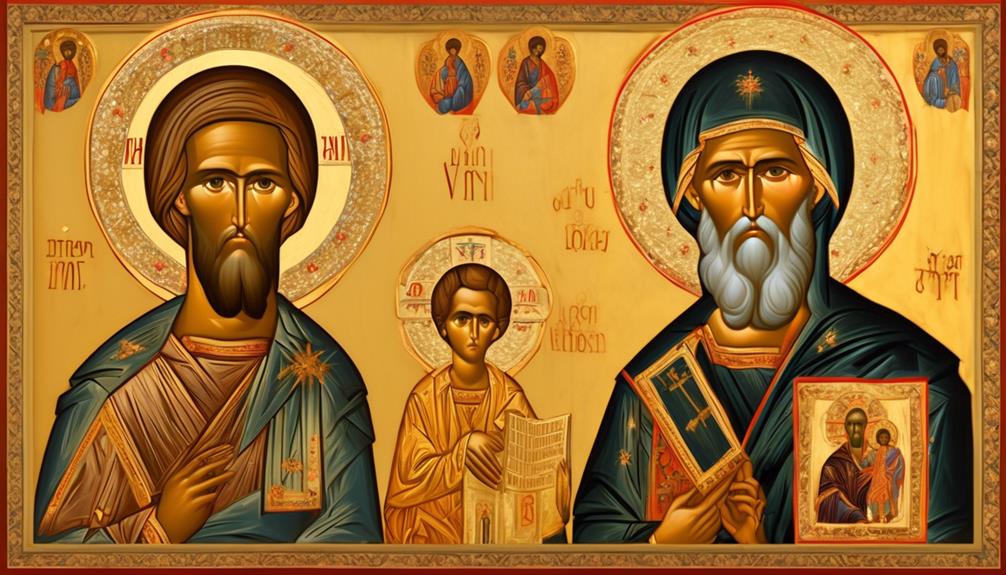
Several distinct iconographic styles have developed within the Orthodox tradition, each with its own unique characteristics and symbolism. The most prominent and enduring style is the Byzantine influence, known for its emphasis on spiritual symbolism, rich colors, and stylized forms. This style originated in the Byzantine Empire and has greatly influenced iconography throughout the Orthodox world. The use of gold leaf, elongated figures, and the positioning of hands and facial expressions all hold deep meaning within this tradition.
In addition to the Byzantine style, there have been modern reinterpretations that seek to maintain the essence of Orthodox iconography while incorporating contemporary elements. These reinterpretations often involve experimentation with color palettes, compositions, and stylistic elements, while still adhering to the underlying principles of Orthodox iconography. While some purists may be wary of modern reinterpretations, they've opened up new avenues for artistic expression and have allowed Orthodox iconography to remain relevant in today's world.
Understanding these various iconographic styles is essential for appreciating the depth and richness of Orthodox iconography and the spiritual significance it holds for Orthodox believers.
Icon Restoration
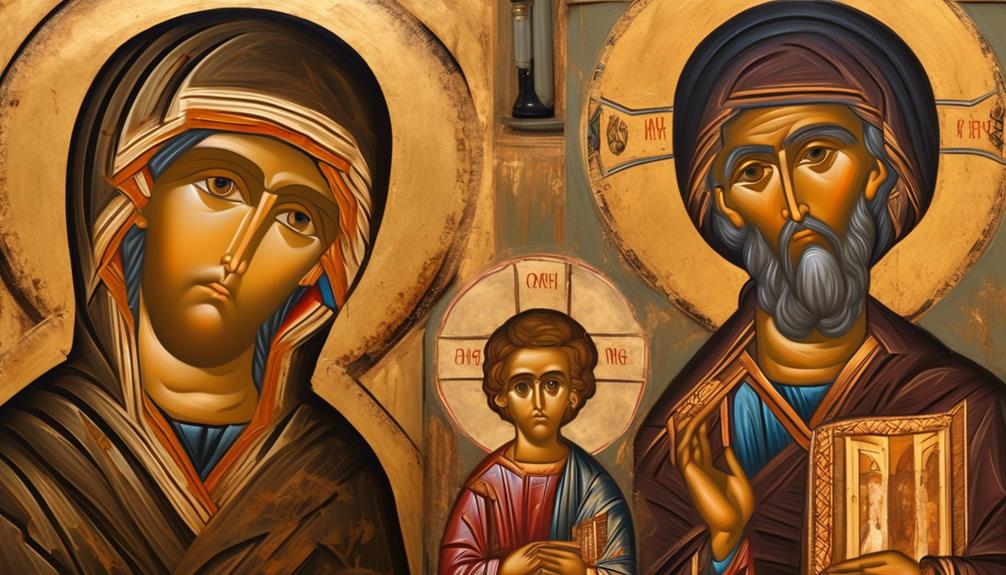
The rich history and symbolism of Orthodox iconographic styles have led to a growing interest in the restoration of these sacred images. When it comes to icon restoration, it's crucial to employ proper techniques that preserve the integrity and historical significance of the icons.
Here are some key points to consider:
- Restoration Techniques
- *Cleaning*: Gentle cleaning methods, such as using natural solvents and soft brushes, are essential to remove dirt and grime without damaging the original paint layers.
- *Retouching*: Skillful and meticulous retouching is necessary to fill in any areas of loss while ensuring that the original artist's work remains prominent.
Icon preservation is more than just addressing visible wear and tear. It involves a deep understanding of the materials and techniques used in creating these timeless pieces. As custodians of these sacred images, we must approach restoration with the utmost care and respect, utilizing techniques that honor the icon's historical and cultural significance.
Controversies and Debates
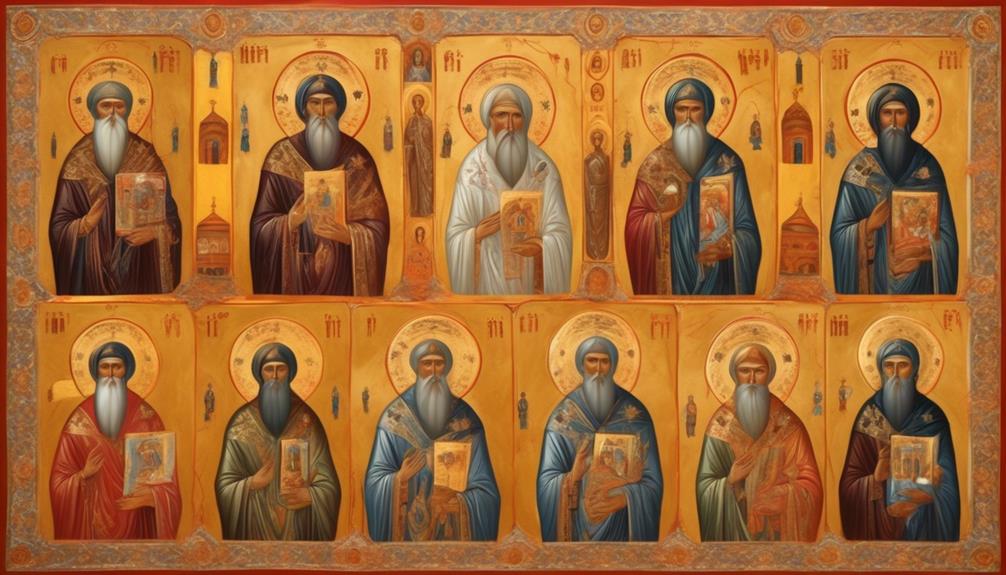
We've all encountered the heated debates surrounding iconography and the controversies over interpretation. These discussions often spark passionate arguments and differing opinions on how certain icons should be depicted and understood.
It's important to navigate these debates with respect and an open mind, acknowledging the rich history and varying perspectives that contribute to the ongoing dialogue about Orthodox icons.
Iconography Debates
In our discussions about Orthodox iconography, we encountered various controversies and debates surrounding the portrayal of sacred images. These debates often revolve around the balance between artistic freedom and religious significance.
Artistic Freedom
- Some argue that artists should have the freedom to interpret and depict religious figures and events in a way that resonates with contemporary audiences.
- Others believe that adhering to traditional iconographic styles is crucial for maintaining the integrity and authenticity of Orthodox icons.
Religious Significance
- Many Orthodox believers emphasize the importance of preserving the religious symbolism and spiritual depth inherent in traditional iconography.
- However, there are ongoing discussions about how to adapt these symbols and styles to effectively communicate the timeless message of the Orthodox faith to modern worshippers.
Interpretation Controversies
Amid ongoing discussions about Orthodox iconography, controversies arise over the interpretation of sacred images, sparking debates about artistic freedom and religious significance.
Interpretation debates often center around how strictly traditional Orthodox iconography should be adhered to versus allowing for artistic interpretation and adaptation to contemporary styles. Some argue that strict adherence to traditional iconographic rules is essential for preserving the religious significance and integrity of the icons.
On the other hand, proponents of artistic freedom believe that adapting iconography to modern artistic styles can make religious imagery more relatable to contemporary worshippers. This religious controversy reflects a broader tension between preserving tradition and adapting to the evolving needs of the faithful.
As discussions continue, finding a balance between tradition and modern interpretation remains a challenge in Orthodox iconography.
Frequently Asked Questions
Are There Specific Rules About the Size and Dimensions of Orthodox Icons?
Size limitations for orthodox icons are typically guided by tradition and can vary depending on the specific iconography. Dimension requirements are often influenced by the intended use and the specific iconographic style.
While there are general guidelines, the details can differ based on regional customs and the preferences of the iconographer. It's important to consider these factors when creating or commissioning Orthodox icons to ensure they align with tradition and intended use.
Can Orthodox Icons Be Displayed in Non-Religious Settings, Such as Homes or Offices?
Absolutely, we believe that Orthodox icons can be displayed in non-religious settings like homes or offices. They not only add a touch of spirituality to the environment but also serve as a reminder of our faith in the midst of our daily activities.
Iconography in public places can provide a sense of connection to our traditions and beliefs, making the space more inviting and calming.
Is There a Specific Process for Blessing or Consecrating Orthodox Icons?
When we talk about blessing or consecrating Orthodox icons, it's important to recognize the significance of these processes.
The blessing process involves a priest invoking God's grace on the icon, while the consecration process involves setting apart the icon for sacred use.
Both processes are deeply meaningful and are conducted with reverence and prayer.
These rituals imbue the icons with spiritual significance and sanctify them for use in religious settings.
Are There Any Rules or Guidelines for Creating Modern or Contemporary Orthodox Icons?
When creating modern interpretations of orthodox icons, we're encouraged to embrace artistic freedom while respecting the traditional guidelines. This allows us to infuse personal expression into the sacred art form.
While honoring the essence of the subject matter, we've room for contemporary interpretation, enabling us to connect the timeless themes with our current experiences.
This balance fosters a deep and intimate understanding of the divine within the context of modernity.
What Is the Significance of the Iconostasis in Orthodox Churches and How Does It Relate to the Rules for Orthodox Icons?
Why is the iconostasis significant in Orthodox churches?
It serves as a visual barrier between the sanctuary and the rest of the worship space, enhancing the sense of sacredness.
The iconography on the iconostasis follows strict rules, depicting saints and scenes from the Bible in specific ways.
This adherence to tradition ensures the preservation of the rich symbolism and spiritual significance of Orthodox icons within the worship space.
Are There Specific Icons Depicted in Eastern Orthodox Books?
Yes, there are specific icons depicted in the best Eastern Orthodox books. These iconic images often include depictions of Jesus Christ, the Virgin Mary, and various saints. These icons play a significant role in Eastern Orthodox worship and are considered a visual representation of sacred figures and events.
Conclusion
In conclusion, Orthodox icons hold deep significance and meaning in the religious and artistic traditions of the Eastern Orthodox Church. These icons aren't just beautiful works of art, but they also serve as a powerful means of connecting with the divine and conveying the spiritual truths of the faith.
Did you know that there are over 300 different iconographic styles used in Orthodox iconography?
- About the Author
- Latest Posts
Introducing Ron, the home decor aficionado at ByRetreat, whose passion for creating beautiful and inviting spaces is at the heart of his work. With his deep knowledge of home decor and his innate sense of style, Ron brings a wealth of expertise and a keen eye for detail to the ByRetreat team.
Ron’s love for home decor goes beyond aesthetics; he understands that our surroundings play a significant role in our overall well-being and productivity. With this in mind, Ron is dedicated to transforming remote workspaces into havens of comfort, functionality, and beauty.
Chinese New Year Decorations
Cultural Decor: When and How to Take Down Chinese New Year Decorations
Master the art of taking down Chinese New Year decorations thoughtfully, while discovering the traditions and tips that can bring you good fortune.

You should take down your Chinese New Year decorations after the Lantern Festival. This timing honors cultural traditions and helps avoid bad luck. Removal symbolizes renewal and makes space for new blessings. As you take down the decor, do it with care, reflecting on their significance. Consider recycling or reusing items for future celebrations to embrace sustainability. Remember, regional customs may influence your approach, so it's worth checking local practices. By respecting these traditions, you reinforce family bonds and community ties. If you want to explore more tips and insights on this topic, keep going!
Key Takeaways
- Traditionally, decorations are taken down after the Lantern Festival, marking the end of Lunar New Year celebrations.
- Early removal is considered inauspicious, while extending decorations may reflect family traditions or regional customs.
- Handle decorations with care during removal, reflecting on their significance and respecting cultural practices.
- Embrace sustainability by recycling or repurposing decorations and organizing them properly for future use.
Timing for Removal
When it comes to taking down your Chinese New Year decorations, most people wait until after the Lantern Festival on the fifteenth day of the lunar new year.
This traditional removal marks the end of the celebrations and is rooted in the belief that keeping the decorations up until then invites good fortune and prosperity.
If you're considering when to take yours down, remember that timing for removal can vary and often hinges on personal preference and family traditions.
Some families prefer to keep the decorations up longer, extending the festive spirit beyond the official end of the celebrations.
This practice can reflect local community traditions, adding a unique touch to how you celebrate.
However, be cautious—removing your decorations too early might be viewed as inauspicious, implying a premature end to your good fortune.
Ultimately, while following traditional guidelines is essential, feel free to adapt them to fit your beliefs and practices.
Whether you stick to the customary timing or choose to leave your Chinese New Year decorations up longer, it's all about what feels right for you and your family.
Cultural Significance

Chinese New Year decorations hold deep cultural significance, symbolizing renewal and the hope for prosperity in the year ahead. During the Chinese New Year holidays, these vibrant decorations serve as a reminder of the blessings and good fortune you seek for the coming year.
Cultural practices about when to remove decorations can vary, but traditionally, you'd take them down after the Lantern Festival, which marks the end of the celebration period.
Removing decorations is more than just tidying up; it's a way to clear out old energy and make space for new blessings. Many believe that leaving decorations up too long can attract bad luck, underscoring the importance of adhering to cultural norms.
This practice reflects the cyclical nature of life, where each year brings a fresh start and opportunities for growth. The timing of taking down decorations connects deeply to themes of renewal, emphasizing that letting go is just as important as celebrating.
Methods for Taking Down

When it's time to take down your Chinese New Year decorations, you'll want to take into account the timing and respect cultural traditions.
Think about how you can recycle or reuse the decor to minimize waste while honoring their significance.
Let's explore the best methods to guarantee a respectful and thoughtful removal process.
Timing for Removal
Taking down decorations after the Lantern Festival is a common practice that marks the end of the Lunar New Year celebrations. The timing for removal typically coincides with this festive day, symbolizing a shift from celebration to everyday life. However, personal preference and local cultural practices can influence when you decide to take down your decorations.
| Timing | Considerations |
|---|---|
| After Lantern Festival | Traditional removal of decorations |
| Extended Celebration | Influenced by personal preferences |
| Local Customs | Different timing in various regions |
When removing decorations, do so carefully to maintain the blessings and good fortune they represent. Many families opt to replace old decorations with new ones for the next New Year celebration, emphasizing renewal and continued prosperity. It is important to respect the meanings behind these cultural practices while making the process enjoyable. Ultimately, the removal can reflect personal beliefs and community traditions, allowing you to honor the spirit of the Lunar New Year even as you shift back to daily life.
Respecting Cultural Traditions
Respecting cultural traditions while removing decorations involves mindful methods that honor the symbols of good fortune and prosperity they represent.
After the Lantern Festival, it's customary to take down your Chinese New Year decorations, but timing can vary based on regional customs and personal preference. Some families prefer to keep their decorations up longer to extend the festive spirit.
When you begin the removal process, handle each decoration with care. Remember that these items symbolize good luck and joy for the coming year.
Avoid hurried or careless removal, as this could be seen as disrespectful. Instead, take your time to reflect on the meaning behind each decoration before you take it down.
As you remove the decorations, consider how your community might've specific traditions that guide this practice. Following local customs not only enhances your experience but also shows respect for the cultural traditions that enrich your celebration.
Ultimately, by being mindful in your approach, you contribute to a deeper understanding of the significance behind the symbols that adorned your home during this important celebration.
Recycling and Reusing Decor
After the Lantern Festival, you can embrace sustainability by recycling and reusing your Chinese New Year decorations.
While some families may choose to keep decorations up longer to extend the festive spirit, many opt to take them down in line with local customs.
When you remove items like paper cuttings and banners, consider recycling them. These materials can be repurposed for crafts or other celebrations, minimizing waste and promoting sustainability.
For decorations that still hold sentimental value, you might want to store them carefully for reuse in future celebrations.
Items such as red lanterns and couplets can easily be preserved, allowing you to bring back the festive spirit year after year. This approach not only reflects personal preference but also supports environmental consciousness.
As you take down your decor, remember to check with family and friends about their preferences on recycling and reusing, ensuring that everyone's traditions are honored.
Storage Tips

When it's time to pack away your Chinese New Year decorations, make certain to store them properly to keep them in great condition for next year. Following tradition, after the Lantern Festival, you should carefully remove your decorations to signify the end of the festive period.
To preserve their quality, find a cool, dry place for storage, keeping them out of direct sunlight to prevent fading and damage.
Organization is key, so use labeled bins or boxes to categorize your items like paper cuttings, lanterns, and couplets. This will make it easier when you set everything up next year.
For delicate items such as paper cuttings, wrap them in acid-free tissue paper to protect against tears and creases during storage.
If you've kept kumquat trees or other plants, make sure they're properly cared for. Shift them to a suitable indoor environment if you plan to keep them post-celebration.
Regional Variations

When it comes to removing Chinese New Year decorations, regional customs play a big role in timing and practices.
You might notice that in southern areas, people keep decorations up longer to savor the festive vibe, while northern regions tend to take them down earlier.
Understanding these local variations can enrich your celebration and connect you more deeply with your community's traditions.
Regional Custom Variations
Understanding the regional variations in customs for taking down Chinese New Year decorations can enrich your appreciation of the festivities.
These regional customs can greatly impact when and how you remove decorations. In many areas, it's traditional to take them down after the fifteenth day of the Lunar New Year, coinciding with the Lantern Festival. This symbolizes the end of the celebration period.
In southern China, families often keep decorations up until the end of the month, wanting to extend the festive spirit and celebrate community events that highlight their cultural heritage.
On the other hand, in northern regions, you'll find that decorations are typically removed more promptly after the Lantern Festival.
Being aware of these local traditions not only enhances your experience but also guarantees you respect the customs of your community.
Whether you choose to follow regional practices or create your own traditions, understanding these variations allows you to engage more deeply with the rich tapestry of celebrations during the Lunar New Year.
Embrace the diversity of customs as part of the joy of the season!
Timing Differences Explained
Regional variations shape the timing of taking down Chinese New Year decorations, with some communities opting for immediate removal while others prefer to extend the festive atmosphere.
In northern China, families often take down their decorations right after the Chinese New Year celebrations wrap up, signaling the end of the festivities.
Conversely, in southern regions, many families keep their decorations up until after the Lantern Festival, the fifteenth day of the Lunar New Year, to prolong the celebratory spirit.
These timing differences reflect local customs and traditions that influence how families celebrate.
Certain communities may have specific events or rituals that dictate when decorations should be removed, showcasing the importance of cultural practices in these regions.
It's not uncommon for families to remove decorations based on personal beliefs or family traditions, highlighting the diversity within Chinese culture.
Ultimately, the timing of taking down decorations varies widely, and it's crucial to respect these regional differences.
Understanding the customs surrounding this practice can help you appreciate the rich tapestry of traditions that make up the celebrations of the Lunar New Year.
Unique Practices Around Removal
Unique practices for removing Chinese New Year decorations vary greatly across different regions, reflecting local customs and beliefs.
In many areas, the tradition is to take down decorations after the Lantern Festival, marking the end of the festive celebrations. This timing signifies a change, allowing families to embrace the new year fully.
However, in southern China, particularly within Cantonese culture, it's common to keep decorations up longer. This practice aims to extend the festive atmosphere and attract continued good fortune. Some families might even opt for removal only when the festive spirit fades, showcasing personal preference and local customs.
Understanding these regional variations can deepen your cultural appreciation and enhance community engagement during the New Year season.
For instance, if you're part of a Cantonese community, you might find that many keep their decorations until well after the Lantern Festival. Alternatively, in other regions, the fresh start of the New Year may prompt immediate removal.
Whatever the custom, being aware of the timing and practices can make your celebration more meaningful and connected to your heritage.
Respecting Traditions

Respecting traditions means acknowledging the significance of when and how to take down Chinese New Year decorations, as these practices reflect deep cultural values and beliefs. Typically, you'd remove decorations after the Lantern Festival, which marks the fifteenth day of the lunar new year. However, some families keep the festive spirit alive by displaying decorations longer, depending on personal preferences or regional customs.
When it's time to take down your decorations, do so gently and with respect. These items symbolize good fortune and positive wishes for the new year, making their removal a meaningful act within the community.
Here's a quick reference to help you navigate this cultural practice:
| Action | Significance |
|---|---|
| Remove after Lantern Festival | Honors the end of the festive season |
| Extend display | Maintains festive spirit |
| Gentle removal | Shows respect for cultural beliefs |
| Follow local customs | Connects with community traditions |
| Share with family | Reinforces family bonds and traditions |
Celebrating New Beginnings

Celebrating new beginnings during Chinese New Year is a time for reflection and renewal, marked by the thoughtful removal of decorations that once adorned your home. After the Lantern Festival, many families embrace this moment to signify the end of festivities and welcome fresh starts.
Here are four key aspects to contemplate during this time:
- Gratitude: Take a moment to express appreciation for the experiences and lessons from the past year.
- Good Fortune: Consider leaving symbolic items, like upside-down fu characters, to invite continuous good fortune into your life.
- Regional Customs: Acknowledge how traditions may vary across different regions, influencing how you approach the removal of decorations.
- Future Aspirations: Use this opportunity for reflections on your goals for the upcoming year, creating a personal plan for renewal.
As you take down your decorations, remember that this process can be just as meaningful as the celebrations themselves. Embrace the spirit of new beginnings, and let your aspirations guide you into the year ahead!
Frequently Asked Questions
When to Take Chinese New Year Decorations Down?
You should take down your Chinese New Year decorations after the Lantern Festival, which is on the fifteenth day of the lunar new year. However, some people prefer to keep them up longer for festive spirit.
What Is the Tradition of Decorating for Chinese New Year?
Decorating for Chinese New Year's like painting a canvas with joy, you'll hang red lanterns and auspicious symbols to invite prosperity. Each decoration serves as a reminder of hope and good fortune for the coming year.
What to Do With Chinese New Year Decorations?
You can store your Chinese New Year decorations for future celebrations, recycle them respectfully, or keep some year-round as lucky reminders. It's all about what feels right for you and your family's traditions.
When Should I Decorate My House for Chinese New Year?
You should decorate your house for Chinese New Year about three to four weeks before the festival. Starting on New Year's Eve or ten days prior is a popular choice to embrace the festive spirit.
Conclusion
As you take down your Chinese New Year decorations, remember that timing and respect for tradition are key.
It's not just about clearing the space; it's about honoring the past year and welcoming the new one.
So, don't rush the process!
Instead, carefully pack away each piece with gratitude, ensuring they're stored safely for next year.
By doing this, you'll truly set the stage for fresh beginnings and good fortune in the year ahead.
- About the Author
- Latest Posts
Introducing Ron, the home decor aficionado at ByRetreat, whose passion for creating beautiful and inviting spaces is at the heart of his work. With his deep knowledge of home decor and his innate sense of style, Ron brings a wealth of expertise and a keen eye for detail to the ByRetreat team.
Ron’s love for home decor goes beyond aesthetics; he understands that our surroundings play a significant role in our overall well-being and productivity. With this in mind, Ron is dedicated to transforming remote workspaces into havens of comfort, functionality, and beauty.
Chinese New Year Decorations
What Is the Symbol for Orthodox Christmas?
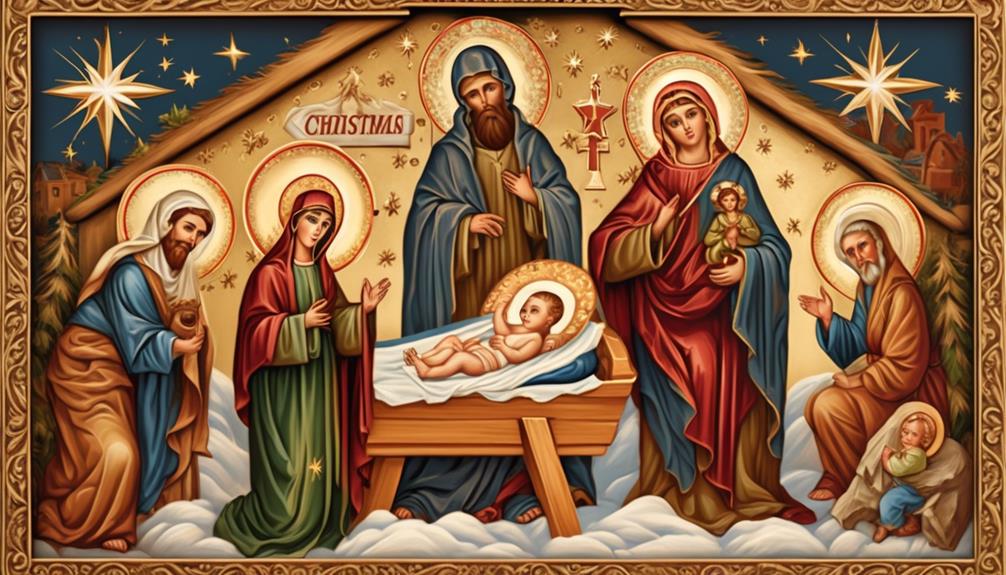
Have you ever thought about the symbol for Orthodox Christmas?
There are various theories and interpretations surrounding this topic, each shedding light on the rich cultural and historical significance behind the symbol.
As we explore the origins and meaning of this symbol, we will uncover its deep-rooted connections to Orthodox faith and its role in global celebrations.
Stay tuned to unravel the mysteries and traditions associated with this iconic symbol.
Key Takeaways
- The symbol for Orthodox Christmas is known as the Nativity icon.
- The Nativity icon represents the birth of Jesus Christ and holds profound symbolic origins.
- The icon conveys the theological truths of the Incarnation, emphasizing the divine and human nature of Jesus Christ.
- The Nativity icon is deeply embedded in the cultural fabric of many communities and represents hope, love, and the unity of families and communities during the holiday season.
Origins of the Symbol
The symbol for Orthodox Christmas, known as the Nativity icon, has its origins deeply rooted in the rich traditions and religious significance of the Eastern Orthodox Church. This iconic representation of the birth of Jesus Christ holds profound symbolic origins, reflecting the theological and spiritual beliefs of the Orthodox Christian faith. The Nativity icon isn't merely a depiction of the birth of Jesus, but it encompasses a wealth of theological meanings and spiritual significance that are central to Orthodox Christian theology.
The symbolic origins of the Nativity icon can be traced back to the early centuries of Christianity, where the visual representation of biblical events became an integral part of Christian worship and devotion. The Nativity icon, through its intricate symbolism and artistic depiction, conveys the theological truths of the Incarnation, emphasizing the divine and human nature of Jesus Christ.
It serves as a visual proclamation of the central beliefs of Orthodox Christianity, encapsulating the profound religious significance of Christmas within its sacred imagery.
Cultural Significance
Rooted in the rich traditions and religious significance of the Eastern Orthodox Church, the Nativity icon holds profound cultural significance that extends beyond its theological and spiritual meanings. The symbolic traditions associated with Orthodox Christmas are deeply embedded in the cultural fabric of many communities.
The Nativity icon, with its depictions of the birth of Jesus, not only serves as a religious symbol but also carries immense cultural weight. Its imagery is often intertwined with festive symbolism, representing hope, love, and the unity of families and communities during the holiday season.
The cultural significance of the Nativity icon is also intertwined with various religious interpretations. It serves as a visual representation of the religious narrative of the birth of Jesus, conveying the central themes of the Orthodox Christmas celebration. The icon's portrayal of the Nativity scene, along with the figures of Mary, Joseph, and the newborn Jesus, holds deep cultural and religious meaning for Orthodox Christians.
The Nativity icon, through its cultural significance and religious interpretations, continues to be a unifying symbol during Orthodox Christmas, fostering a sense of shared identity and tradition within these communities.
Symbolic Representation
Embedded in the cultural fabric and religious traditions of the Eastern Orthodox Church, the Nativity icon holds profound symbolic significance for Orthodox Christmas. Symbolic representation in Orthodox Christianity is rich and deeply rooted in tradition.
The Nativity icon, depicting the birth of Jesus Christ, is a powerful symbol that encapsulates the essence of the Orthodox Christmas. The icon is adorned with religious symbolism, portraying the Virgin Mary, the infant Jesus, the adoration of the shepherds, and the visitation of the Magi. Each element in the icon carries specific religious significance, offering a visual representation of the theological beliefs surrounding the birth of Christ.
In contrast to other Christian denominations, Orthodox symbolism often emphasizes the mystery and transcendence of divine events. The Nativity icon, through its intricate symbolism, invites believers to contemplate the spiritual truths of Christmas, fostering a deep sense of reverence and awe.
The symbolic representation in Orthodox Christmas serves as a profound reminder of the divine significance of the Incarnation, inviting believers to meditate on the sacred mysteries of the faith.
Traditional Iconography
In exploring the significance of Orthodox Christmas, the traditional iconography of the Nativity holds a pivotal role in conveying the rich symbolism and spiritual depth of this religious observance. Traditional art in Orthodox Christianity plays a profound role in depicting the Nativity, often focusing on religious symbolism to convey the divine aspects of the birth of Jesus Christ. The traditional iconography of the Nativity typically includes the Virgin Mary, the infant Jesus, and Joseph, often surrounded by shepherds, angels, and the Star of Bethlehem. Each element is meticulously crafted to symbolize profound spiritual truths and convey the significance of the event.
Comparatively, traditional iconography in Orthodox Christmas art often differs from Western Christian depictions. The emphasis on religious symbolism and the use of rich, vibrant colors in Orthodox iconography are distinctive features that set it apart. The careful attention to detail and adherence to specific artistic traditions further enhance the spiritual depth of these representations. Through traditional iconography, Orthodox Christmas art continues to serve as a powerful medium for believers to connect with the sacred narrative of the Nativity and its enduring significance.
Historical Evolution
As we explore the historical evolution of the symbol for Orthodox Christmas, it's important to consider its symbolic significance and the cultural variations that have emerged over time.
By analyzing the changes in the depiction of this symbol across different historical periods and cultural contexts, we can gain valuable insights into its evolving meaning and relevance.
Through a comparative lens, we can also examine how various traditions and interpretations have shaped the symbol's representation in diverse Orthodox communities.
Symbolic Significance
The symbolic significance of the Orthodox Christmas has evolved over centuries, reflecting a rich tapestry of historical, cultural, and religious influences. In the Orthodox tradition, symbolic representation is deeply intertwined with religious customs, each carrying profound meaning and significance. The table below provides a comparative analysis of the symbolic significance of Orthodox Christmas in various cultures and traditions.
| Symbolic Representation | Religious Custom |
|---|---|
| Nativity Icon | Fasting |
| Twelve Lenten Dishes | Midnight Liturgy |
| Yule Log | Holy Communion |
| Star of Bethlehem | Caroling |
| Angels | Epiphany |
These symbols and customs are not only a reflection of historical traditions but also serve to deepen the spiritual significance of Orthodox Christmas, providing a sense of intimacy and reverence for believers around the world.
Cultural Variations
The evolution of the symbolic significance of Orthodox Christmas is evident in the diverse cultural variations and historical influences that have shaped the celebration over time.
Cultural practices and holiday customs associated with Orthodox Christmas vary widely across different regions where it's celebrated. For instance, in some Eastern European countries, the holiday is marked with a twelve-course meatless Christmas Eve supper, while in others, it's customary to attend midnight church services.
Additionally, historical influences such as the Byzantine and Ottoman empires have contributed to the unique customs and traditions observed during Orthodox Christmas. These cultural variations highlight the rich tapestry of customs and practices that have developed over centuries, showcasing the diversity and depth of the celebration of Orthodox Christmas across different regions and communities.
Symbol's Religious Meaning
Celebrated by Orthodox Christians, the symbol of the Christmas holiday holds deep religious significance. The symbol's interpretation varies across different Orthodox Christian traditions, yet the religious significance remains central.
In the Eastern Orthodox Church, the primary symbol of Orthodox Christmas is the Nativity icon, depicting the birth of Jesus Christ in Bethlehem. This icon serves as a visual representation of the religious significance of the holiday, reminding believers of the central event in Christian theology. The Nativity icon often includes symbolic elements such as the cave where Christ was born, the manger, the Star of Bethlehem, and the presence of angels and shepherds, all of which carry profound religious meanings.
In contrast, other Orthodox traditions may emphasize different symbols, such as the Yule log in some Eastern European cultures, yet the religious significance of these symbols remains connected to the birth of Jesus Christ.
Despite variations in the symbols used to celebrate Orthodox Christmas, the religious meaning underlying these symbols serves to unite Orthodox Christians in their shared faith and devotion to the Nativity of Christ.
Regional Variations
Regional variations in the observance of Orthodox Christmas introduce diverse customs and practices that reflect the rich cultural tapestry of Orthodox Christian communities worldwide. Symbolic attire and ritual practices hold significant importance in the celebration of Orthodox Christmas, and the variations in these aspects further highlight the unique traditions within different regions.
| Region | Symbolic Attire | Ritual Practices |
|---|---|---|
| Russia | Traditional embroidered clothing, such as sarafans and kokoshniks, symbolizing the country's rich cultural heritage and history. | The Christmas Eve meal, known as Holy Supper, is a central ritual consisting of 12 meatless dishes, symbolizing the 12 apostles, and is accompanied by prayers and carol singing. |
| Greece | Garments featuring intricate designs and patterns, representing the country's deep-rooted connection to Byzantine art and religious symbolism. | The lighting of the Christmas boat, symbolizing the birth of Christ and the sea-faring traditions of the Greek people, is a significant ritual observed in coastal regions. |
| Ethiopia | White traditional garments symbolizing purity and renewal, often adorned with intricate patterns and colors. | The three-day fast, known as 'Gahad of the Fast', precedes Christmas and is followed by attending a colorful and vibrant church service on Christmas Eve. |
These regional variations not only add depth to the observance of Orthodox Christmas but also foster a sense of unity and understanding among Orthodox Christian communities around the world.
Symbol in Art and Decor
Symbolism in Orthodox Christmas art and decor plays a significant role in conveying the rich cultural and religious heritage of Orthodox Christian communities worldwide. Artistic interpretations often feature religious motifs such as the Nativity scene, depicting the birth of Jesus Christ, and the Adoration of the Magi, symbolizing the visit of the Three Wise Men. These artistic representations aren't only decorative but also carry deep spiritual significance, reminding believers of the core tenets of their faith.
Additionally, decorative symbolism in Orthodox Christmas art frequently includes elements like the use of gold and silver, symbolizing the divine and eternal nature of Christ, and the presence of angels, symbolizing the messengers of God who announced the birth of Jesus.
Comparatively, Orthodox Christmas art and decor may differ in style and specific symbols based on regional traditions and cultural influences. For example, in Eastern Orthodox traditions, icons are a prominent feature, serving as a form of religious art that holds deep symbolism and spiritual meaning. In contrast, Western Orthodox communities may incorporate different artistic styles and decorative symbols, reflecting their unique cultural expressions while still honoring the universal significance of the Christmas story.
Contemporary Interpretations
In exploring contemporary interpretations of Orthodox Christmas art and decor, we find that new expressions continue to reflect the rich cultural and religious heritage while embracing modern influences. Today, there's a growing trend of blending traditional Orthodox Christmas symbols with modern relevance. Artists and designers are infusing classic icons like the Nativity scene, the star of Bethlehem, and the cross with contemporary elements to resonate with today's audience.
Contemporary interpretations of Orthodox Christmas art often incorporate minimalist and abstract approaches, symbolizing simplicity and universality. This allows the art to be more inclusive and relatable to a broader audience, transcending cultural and religious boundaries. Moreover, there's an emphasis on sustainability and eco-friendly materials, reflecting a modern concern for environmental consciousness.
In the realm of decor, there's a shift towards sleek and modern designs that complement a variety of interior styles. Traditional colors such as gold, deep red, and forest green are being paired with neutrals and metallic accents, creating a harmonious blend of classic and contemporary aesthetics. This fusion of old and new ensures that Orthodox Christmas remains deeply rooted in tradition while resonating with the modern world.
Symbol in Orthodox Celebrations
Orthodox Christmas celebrations incorporate a myriad of symbols that reflect the rich spiritual and cultural significance of the holiday. Symbolic imagery plays a central role in these celebrations, conveying profound religious meanings and connecting participants to centuries-old traditions. Some of the most prominent symbols include:
- Nativity Iconography: Orthodox Christmas is often depicted through intricate and symbolic iconography, portraying the birth of Christ and the adoration of the Magi. These icons serve as a visual representation of the divine mystery of the Incarnation.
- Candlelight: The use of candles during Orthodox Christmas symbolizes the light of Christ illuminating the world, bringing hope and dispelling darkness. Candles are lit during religious services and in homes, creating a warm and reverent atmosphere.
- Traditional Foods: Festive customs are deeply intertwined with Orthodox Christmas celebrations, with special foods like kutia, a wheat berry pudding, and pirozhki, a type of pastry, holding symbolic meanings of prosperity, unity, and the sweetness of life.
These symbolic elements enrich the Orthodox Christmas experience, fostering a sense of spiritual connection and cultural continuity. The interplay of symbolic imagery and festive customs creates a deeply meaningful and immersive celebration.
Symbol's Global Recognition
The symbol of Orthodox Christmas holds cultural significance that extends beyond religious traditions and festive decorations. Understanding its global recognition allows for a comparative analysis of the ways different cultures and regions incorporate this symbol into their celebrations.
Cultural Significance
Symbolizing the cultural richness and spiritual significance of Orthodox Christmas, the symbol holds a global recognition that transcends borders and unites diverse communities in celebration. The symbolic interpretations and cultural variations of the Orthodox Christmas symbol reflect the unique practices and beliefs of different regions, fostering a sense of unity among Orthodox Christians worldwide.
Whether it's the festive decorations adorning homes and churches or the religious traditions observed during this time, the symbol serves as a unifying emblem that connects people across continents. Its ability to evoke a deep sense of reverence and joy makes it an integral part of the collective consciousness, transcending language barriers and cultural differences.
This universal recognition underscores the symbol's profound impact on the global celebration of Orthodox Christmas.
Religious Traditions
Amidst the global celebration of Orthodox Christmas, the symbol's universal recognition underscores its profound impact on religious traditions worldwide.
Religious practices and holiday customs vary significantly between different cultures and regions. The symbol for Orthodox Christmas serves as a unifying emblem across diverse religious traditions, symbolizing hope, peace, and the spirit of giving. Its recognition transcends geographical boundaries, resonating with believers and non-believers alike, fostering a sense of shared humanity and spiritual interconnectedness.
Comparatively, the symbol's global recognition highlights the common threads that run through various religious traditions, emphasizing the universal values of love, compassion, and unity.
As we celebrate this joyous occasion, it's essential to acknowledge the symbol's role in bridging cultural divides and promoting understanding and respect for diverse religious traditions.
Festive Decorations
As we explore the topic of festive decorations for Orthodox Christmas, it's intriguing to consider the global recognition of the symbol and its profound impact on religious traditions worldwide.
Festive ornaments play a pivotal role in celebrating Orthodox Christmas, enriching holiday traditions with vibrant colors and meaningful symbols.
When comparing festive decorations for Orthodox Christmas with those of other religious holidays, we find that each tradition holds its unique significance and beauty.
The use of traditional elements such as evergreen wreaths, candles, and nativity scenes creates a sense of unity and continuity across different cultures.
These decorations serve as a powerful reminder of the shared values and beliefs that bring people together during this joyous season, transcending geographical and cultural boundaries.
Importance in Orthodox Faith
Orthodox Christmas holds significant importance in the Orthodox faith, symbolizing the birth of Jesus Christ and serving as a time of spiritual reflection and celebration for believers. The symbolic imagery of the birth of Christ holds deep religious significance, reminding Orthodox Christians of the central event in Christian theology. It's a time when iconographic representations of the Nativity are prominently displayed, emphasizing the spiritual importance of this event in the life of believers. The birth of Jesus is seen as the fulfillment of prophecies and the manifestation of God's love and mercy to humanity.
In the Orthodox faith, the celebration of Christmas isn't just a historical remembrance but a deeply spiritual occasion. It serves as a reminder of the profound theological implications of the Incarnation, signifying God becoming human to redeem mankind. This event is a source of great joy and hope for Orthodox Christians, as it represents the divine intervention in the world. The birth of Christ is a transformative event that holds immense significance in the Orthodox faith, shaping the beliefs and practices of its followers.
Frequently Asked Questions
How Do Orthodox Christians Typically Incorporate the Symbol of Christmas Into Their Daily Lives and Routines?
Incorporating the symbol of Christmas into our daily lives and routines is a deeply meaningful tradition for Orthodox Christians.
The cultural significance of festive decorations and family traditions holds great importance.
We often adorn our homes with symbolic decorations like the nativity scene, icons, and evergreen branches as a way to honor and celebrate the birth of Jesus Christ.
These traditions create a sense of warmth, togetherness, and spiritual significance in our daily lives.
Are There Any Specific Rituals or Customs Associated With the Symbol of Orthodox Christmas That Are Not Mentioned in the Article?
Specific rituals and customs associated with Orthodox Christmas symbolize the rich cultural heritage and spiritual significance. From traditional food and drinks to festive decorations, these customs honor the historical origins and spiritual meanings.
Artistic representations also play a significant role in celebrating Orthodox Christmas, bringing the community together in joyous family gatherings and lively community events.
It's fascinating how these customs and celebrations have evolved over time, reflecting the enduring traditions and values.
What Materials or Colors Are Traditionally Used to Create or Depict the Symbol of Orthodox Christmas?
Traditionally, materials like wood, straw, and fabric in earthy tones like brown and green are used to create or depict the symbol of Orthodox Christmas. The symbolism behind these materials and colors reflects the humble and natural origins of the holiday.
While traditional practices emphasize simplicity and authenticity, contemporary adaptations may incorporate modern materials and a wider color palette.
Are There Any Specific Prayers or Blessings Associated With the Symbol of Orthodox Christmas?
When it comes to the symbolic significance of Orthodox Christmas, there are specific prayers and blessings associated with the holiday traditions. These prayers hold deep spiritual significance and are an integral part of the festive decorations.
They evoke a sense of reverence and gratitude, adding a layer of spiritual depth to the celebrations. The prayers and blessings serve as a reminder of the sacred and joyous nature of the holiday.
How Has the Symbol of Orthodox Christmas Been Influenced or Adapted in Modern Times?
In modern times, the symbol of Orthodox Christmas has been notably influenced by media and commercialization. We've seen an increase in the portrayal of Orthodox Christmas symbols in movies, advertisements, and social media, which has contributed to a broader awareness and understanding of the holiday.
However, this increased visibility has also led to the commercialization of the symbol, with many products and promotions using Orthodox Christmas imagery for profit.
Is the Symbol for Orthodox Christmas the Same as the Greeting for Coptic Christmas?
Yes, the symbol for Orthodox Christmas is the same as the greeting for Coptic Christmas. “Joyful Nativity” is traditionally used as the coptic Christmas greeting custom, and it also represents the birth of Jesus in the Orthodox tradition. Both use this symbol to celebrate the holiday.
Conclusion
In conclusion, the symbol for Orthodox Christmas stands as a beacon of hope and tradition, guiding believers through the ages with its rich cultural significance and deep-rooted symbolism.
Like a shining star in the night sky, it represents the enduring faith and spiritual journey of the Orthodox community, illuminating the path towards divine celebration and joyous festivities.
Its global recognition and importance in Orthodox faith continue to make it a cherished and revered emblem of Christmas.
- About the Author
- Latest Posts
Introducing Ron, the home decor aficionado at ByRetreat, whose passion for creating beautiful and inviting spaces is at the heart of his work. With his deep knowledge of home decor and his innate sense of style, Ron brings a wealth of expertise and a keen eye for detail to the ByRetreat team.
Ron’s love for home decor goes beyond aesthetics; he understands that our surroundings play a significant role in our overall well-being and productivity. With this in mind, Ron is dedicated to transforming remote workspaces into havens of comfort, functionality, and beauty.
Chinese New Year Decorations
What Is the Greeting for Coptic Christmas?
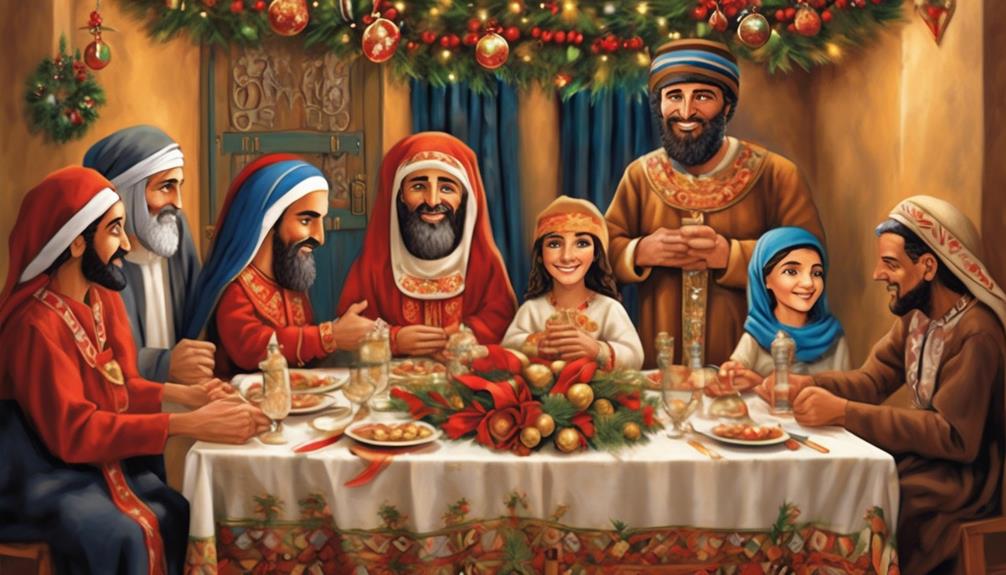
Have you ever wondered about the unique greeting for Coptic Christmas amidst the diverse range of greetings exchanged during the holiday season?
It's a tradition that holds deep cultural significance and carries a special message.
Understanding the origins and meaning behind this greeting can provide valuable insights into the rich tapestry of Coptic Christmas traditions.
Join me as we uncover the mystery behind this heartfelt greeting and its importance in the celebrations.
Key Takeaways
- The Coptic Christmas greeting holds deep cultural and religious significance for the Coptic Orthodox community.
- It plays a pivotal role in connecting individuals within the community and symbolizes the unity and shared celebration of faith and tradition.
- The greeting reflects the rich history and heritage of the Coptic community, embodying themes of love, peace, and unity.
- It fosters a sense of community and belonging, strengthens cultural identity, and forms the foundation of the Coptic Christmas festivities.
Significance of Coptic Christmas Greeting
The Coptic Christmas greeting holds deep cultural and religious significance for the Coptic Orthodox community, signifying the joyous celebration of the birth of Jesus Christ. Beyond its religious importance, this greeting plays a pivotal role in connecting individuals within the community, spreading joy and fostering social connections. It's not just a simple exchange of words; it's a heartfelt expression that transcends generations, binding the community together in a shared celebration of faith and tradition.
The greeting is a symbol of cultural importance, passed down through centuries, and is deeply ingrained in the fabric of Coptic society. As we exchange this greeting, whether with family, friends, or fellow church members, we aren't only acknowledging the birth of Jesus Christ but also reinforcing the bonds that tie us together. This simple yet profound gesture carries the weight of tradition and the warmth of shared beliefs, making it a powerful tool for cultivating a sense of unity and belonging.
In essence, the Coptic Christmas greeting goes beyond mere words; it's a conduit for spreading joy and strengthening social connections within the Coptic Orthodox community, embodying the profound significance and cultural richness of this festive tradition.
Origins of the Coptic Christmas Greeting
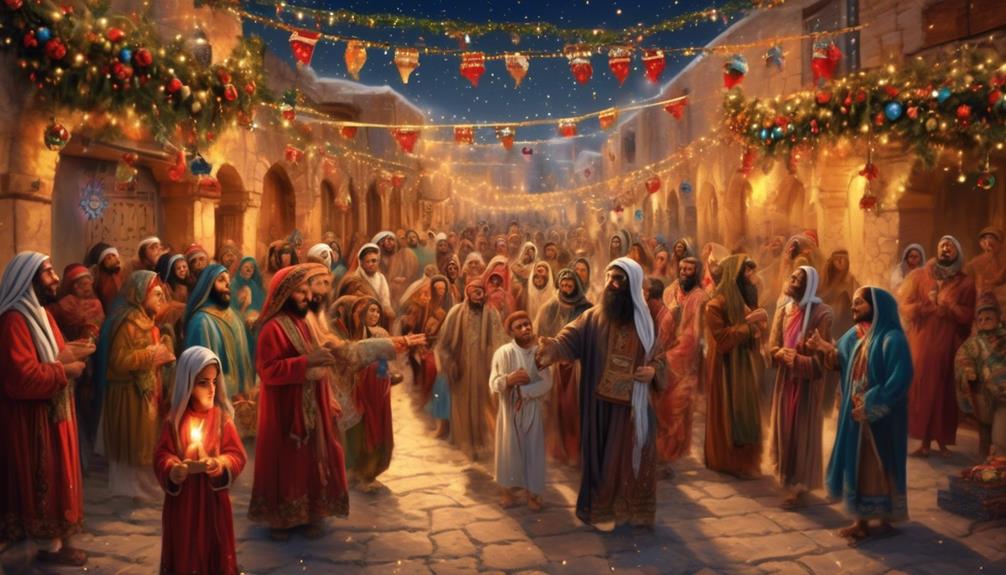
Centuries ago, our ancestors in the Coptic Orthodox community crafted a heartfelt and enduring Christmas greeting that continues to resonate with deep cultural and religious significance today. The origins of the Coptic Christmas greeting can be traced back to the early days of Christianity in Egypt, where it evolved over time to become an integral part of Coptic cultural and religious practices. This greeting has not only survived but has also evolved, adapting to the changing cultural and religious landscape while retaining its core symbolism and meaning. The evolution of the greeting reflects the rich cultural tapestry of the Coptic community and symbolizes the enduring faith and resilience of its people. The table below summarizes the cultural and symbolic significance of the Coptic Christmas greeting:
| Cultural Significance | Symbolism | Evolution |
|---|---|---|
| Deeply rooted in Coptic tradition and community | Represents the enduring faith and resilience of the Coptic people | Adapted to changing cultural and religious landscapes |
The greeting serves as a powerful reminder of the enduring traditions and beliefs that have been passed down through generations, embodying the rich heritage of the Coptic Orthodox community.
Traditional Coptic Christmas Greeting
Crafting a traditional Coptic Christmas greeting involves weaving together cultural and religious symbolism to convey heartfelt wishes and blessings. This greeting is deeply rooted in cultural tradition, reflecting the rich history and heritage of the Coptic community. It's a time-honored expression of joy and goodwill, embodying the spirit of festive celebrations.
The traditional Coptic Christmas greeting encapsulates the essence of the holiday season, encompassing themes of love, peace, and unity. It serves as a heartfelt expression of good wishes, not only for the recipient but for their entire family and community. Through this greeting, we extend warm regards and blessings, acknowledging the significance of this joyous occasion.
Embracing the traditional Coptic Christmas greeting is a cherished practice that fosters a sense of togetherness and belonging within the community. It serves as a reminder of the enduring customs and values that have been passed down through generations, enriching the festive celebrations with profound meaning and significance.
This timeless gesture embodies the essence of the holiday, uniting us in shared joy and goodwill.
Cultural Importance of Greeting in Coptic Christmas
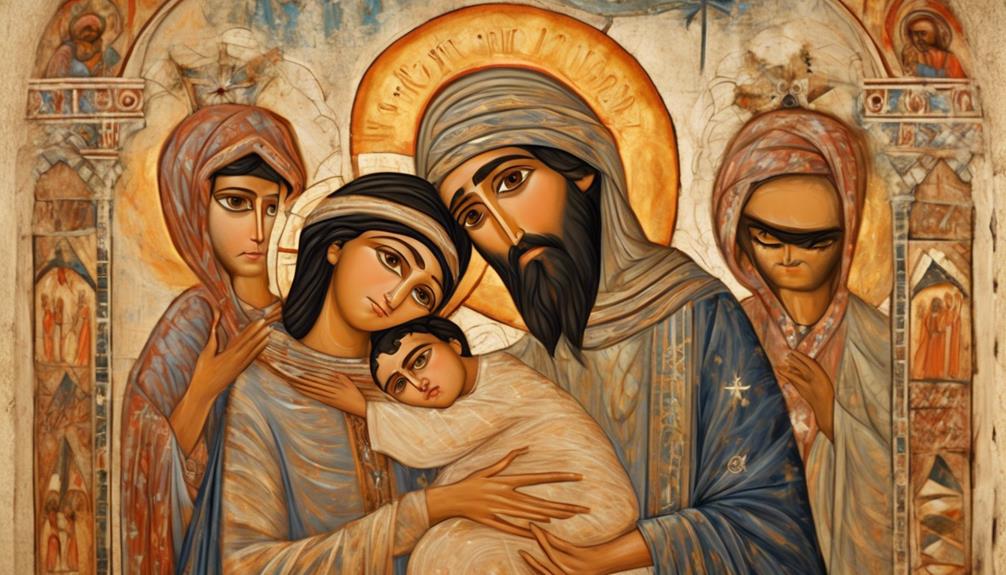
Observing the cultural importance of greeting in Coptic Christmas, we find a tradition deeply intertwined with the fabric of community and heritage. The exchange of greetings during Coptic Christmas is not just a formality; it is a reflection of the cultural traditions and festive celebrations that have been passed down through generations. The act of exchanging greetings brings people together, fostering a sense of belonging and unity within the community. It serves as a reminder of the shared values and beliefs that form the foundation of the Coptic Christmas festivities.
| Cultural Traditions | Importance |
|---|---|
| Exchange of Greetings | Reflects shared values and beliefs |
| Festive Celebrations | Fosters sense of community and belonging |
| Heritage | Strengthens cultural identity |
Spreading Joy With Coptic Christmas Greetings
Spreading joy with Coptic Christmas greetings enhances our sense of community and strengthens our cultural identity. As we exchange these heartfelt greetings, we not only express our joy for the festive season but also foster a deeper connection with our community. Here's how spreading Coptic Christmas greetings can truly bring joy and strengthen cultural exchange:
- Building Bridges: Greetings create an opportunity for cultural exchange, allowing us to share the beauty of our traditions with others.
- Fostering Unity: By spreading joy through greetings, we reinforce a sense of togetherness and solidarity within our community.
- Preserving Traditions: Sharing Coptic Christmas greetings helps preserve our rich cultural heritage and ensures that our traditions continue to thrive.
- Creating Memories: These greetings become cherished memories, adding to the joyful atmosphere of the holiday season for both the sender and the recipient.
- Spreading Happiness: The simple act of exchanging heartfelt greetings spreads happiness and uplifts the spirits of everyone involved, creating a warm and festive atmosphere.
Exchanging Well-Wishes on Coptic Christmas
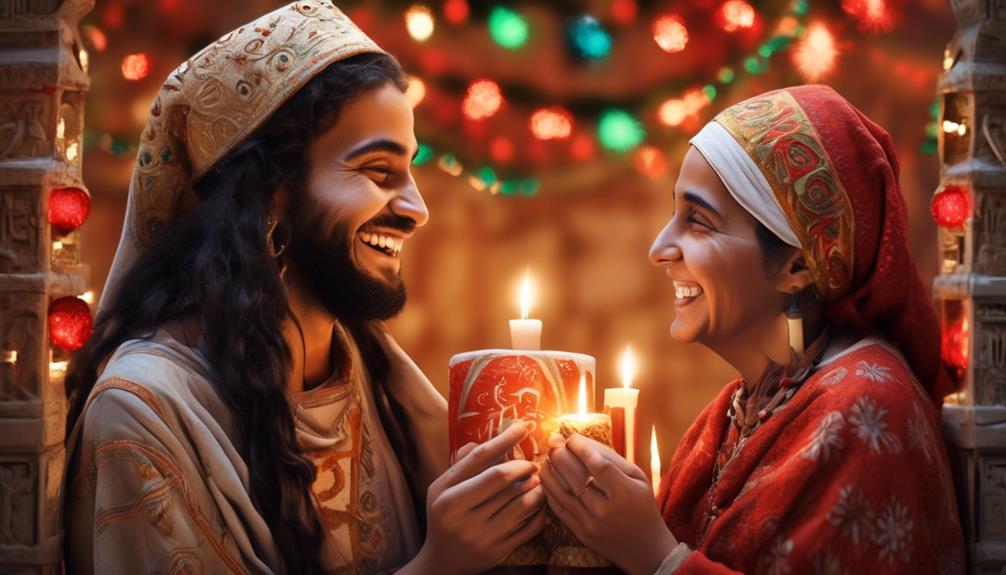
Exchanging well-wishes on Coptic Christmas brings joy and strengthens our sense of community and cultural identity. It's a time when we come together to exchange blessings and share joy, upholding cherished holiday traditions and cultural rituals. The simple act of wishing someone well on this special day fosters a deeper connection and reinforces the bonds of our community.
As we exchange heartfelt greetings and blessings with family, friends, and even strangers, we're reminded of the beauty of our shared heritage and the warmth of our cultural traditions.
These well-wishes serve as a reminder of the values and principles that unite us, filling our hearts with a sense of belonging and togetherness. Through this exchange, we not only spread joy but also honor the rich tapestry of our cultural identity. It's a beautiful way to celebrate Coptic Christmas, reaffirming our ties to one another and expressing our shared hopes for peace, prosperity, and goodwill.
In these moments of connection and celebration, we find strength and comfort in the embrace of our community, fostering a sense of unity that transcends time and distance.
The Meaning Behind Coptic Christmas Greeting
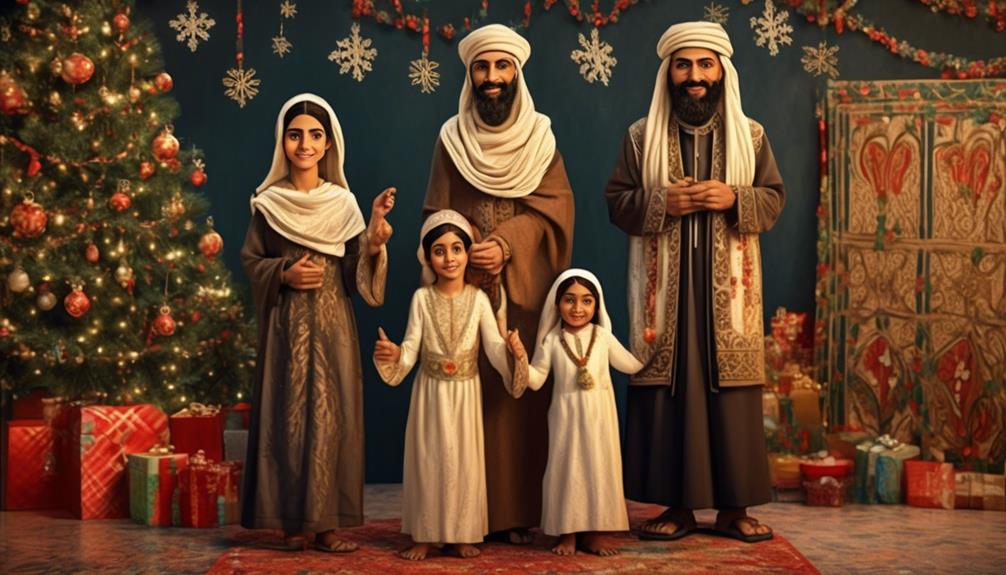
So, let's talk about the meaning behind Coptic Christmas greetings.
The tradition of exchanging well-wishes on Coptic Christmas holds great cultural significance within the Coptic Christian community.
Understanding the deeper meaning behind these greetings can provide insight into the values and beliefs cherished by individuals celebrating this special occasion.
Coptic Christmas Greeting Tradition
The Coptic Christmas greeting tradition holds deep significance within the Coptic Orthodox community, embodying a message of joy, peace, and spiritual renewal. This tradition is a beautiful reflection of our cultural importance and the unity it fosters among us.
Here's why this tradition is so meaningful:
- Spreading Joy: The greetings exchanged during Coptic Christmas are a way of spreading joy and warmth among our community members.
- Well Wishes: It's a time for us to convey heartfelt well wishes for the holiday season and the year ahead.
- Cultural Significance: The tradition reinforces our cultural identity and strengthens our bond as a community.
- Social Connections: It provides an opportunity to strengthen social connections and build camaraderie.
- Unity: By exchanging these greetings, we reinforce the sense of unity and togetherness that's integral to our faith and heritage.
Cultural Significance of Greeting
Celebrating Coptic Christmas through the traditional greeting holds deep cultural significance, embodying the spirit of joy, unity, and spiritual renewal within the Coptic Orthodox community.
The greeting 'El Milad Majid' reflects the cultural traditions and holiday customs of the Coptic Christmas, signifying the birth of Jesus Christ. It serves as a symbol of solidarity, love, and respect among Coptic Christians, fostering a sense of belonging and togetherness during this sacred time.
The exchange of this greeting is a cherished ritual that reinforces the shared values and beliefs of the community, reinforcing the importance of faith and tradition. It's a beautiful expression of the rich cultural heritage and religious devotion that characterize the Coptic Christmas celebration, connecting individuals in a profound and meaningful way.
Coptic Christmas Greeting Customs
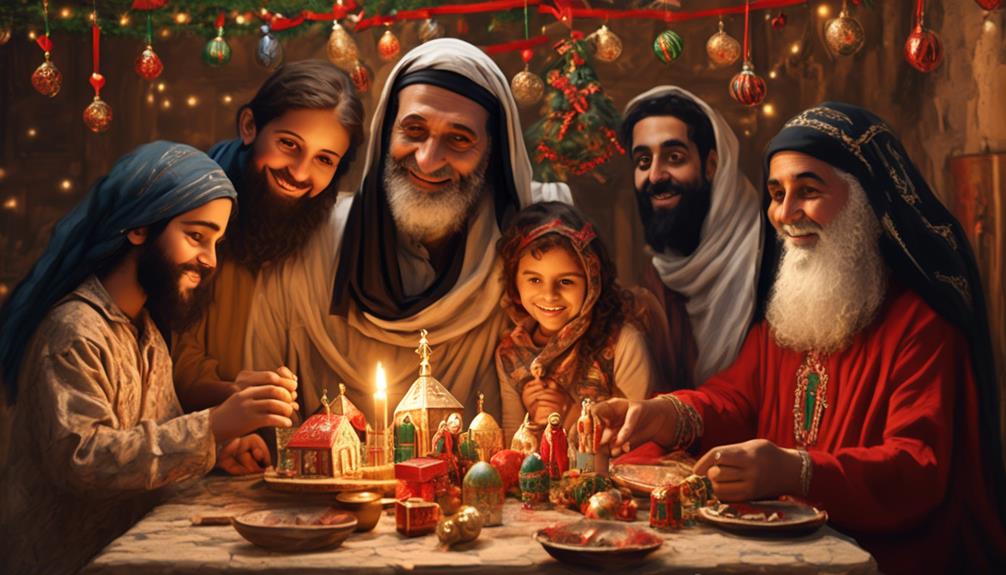
We'll explore the traditional and modern customs of Coptic Christmas greetings.
From the heartfelt traditional greetings passed down through generations to the innovative ways of expressing holiday wishes in today's digital age, Coptic Christmas greetings have evolved with time.
Understanding these customs provides insight into the rich cultural traditions surrounding Coptic Christmas celebrations.
Traditional Coptic Greetings
During the Coptic Christmas season, it's customary to exchange traditional greetings that convey blessings and well-wishes for the occasion. Traditional Coptic greetings hold deep cultural significance and are an integral part of our festive celebrations. When exchanging greetings during Coptic Christmas, consider the following:
- Invoke Blessings: Use phrases such as 'Kul sana wa inta tayeb' (كل سنة و إنت طيب) which means 'May every year find you in good health' to express blessings and well-wishes.
- Embrace Tradition: Emphasize the importance of cultural traditions by using greetings like 'El Milad Majid' (الميلاد مجيد) meaning 'Glorious Birth' to honor the religious and cultural significance of the occasion.
- Share Joy: Spread happiness and joy by greeting with 'Eid Wahda' (عيد واحد) which translates to 'One feast' signifying unity and togetherness during this festive season.
- Express Gratitude: Show appreciation and gratitude by using 'Naharak Saeed' (نهارك سعيد) or 'Nahar en Naby' (نهار النبي) to convey 'Happy Day' or 'Prophet's Day' respectively.
- Spread Love: Capture the essence of love and compassion with 'El Mawlid Sameh' (المولد سعيد) meaning 'Merry Christmas' to share love and joy with others.
Modern Coptic Greetings
Modern Coptic greetings have evolved to incorporate contemporary language and expressions while still upholding the traditional values and sentiments of the occasion. In today's Coptic community, greetings for Christmas have taken on modern practices and cultural expressions that reflect the diverse and dynamic nature of the celebrants. Below is an example of how modern Coptic greetings may appear:
| English | Coptic Transliteration | Coptic Translation |
|---|---|---|
| Merry Christmas! | Colo sana wintom tieb | Happy New Year! |
| Happy Holidays! | Pi'agi ente epnevma | Blessed feast |
| Joy and peace! | Owoot en pi'agi | Joy in the feast |
These modern greetings demonstrate the fusion of traditional Coptic values with contemporary expressions, allowing for a meaningful exchange of warm wishes during the Christmas season.
Sharing Greetings in Coptic Christmas Celebrations
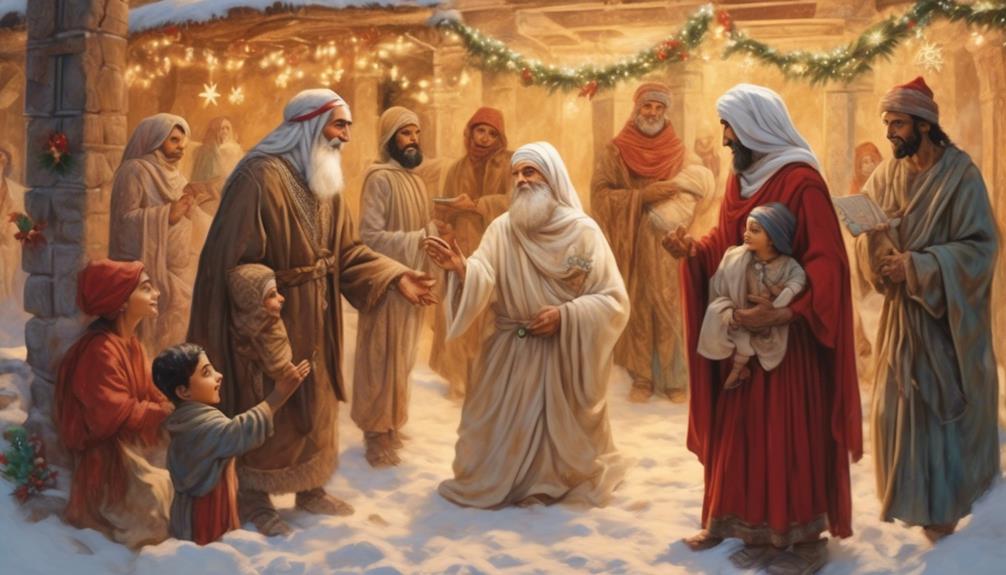
In Coptic Christmas celebrations, exchanging traditional greetings holds a special significance for the community. It's a time when we come together to share joy and blessings with one another.
Here are some key ways we share greetings during this festive time:
- 'Colo sana wintom tiebeen': This traditional Coptic greeting translates to 'May you be well every year' and is commonly used to wish others a blessed and prosperous year ahead.
- Warm Embraces: In our community, hugs and embraces are a common way to express our love and warmth towards each other during the Christmas celebrations.
- Offering Prayers: We often exchange greetings by offering prayers for each other's well-being and happiness during the Christmas season.
- Gift-giving: Sharing gifts is another way we convey our warm wishes and spread joy during the festive season.
- Festive Feasts: Coming together for communal meals and feasting is a time-honored way for us to exchange greetings and celebrate the joyous occasion.
These traditions help us create a sense of togetherness and convey our heartfelt wishes for a wonderful Christmas season.
Impact of Coptic Christmas Greetings
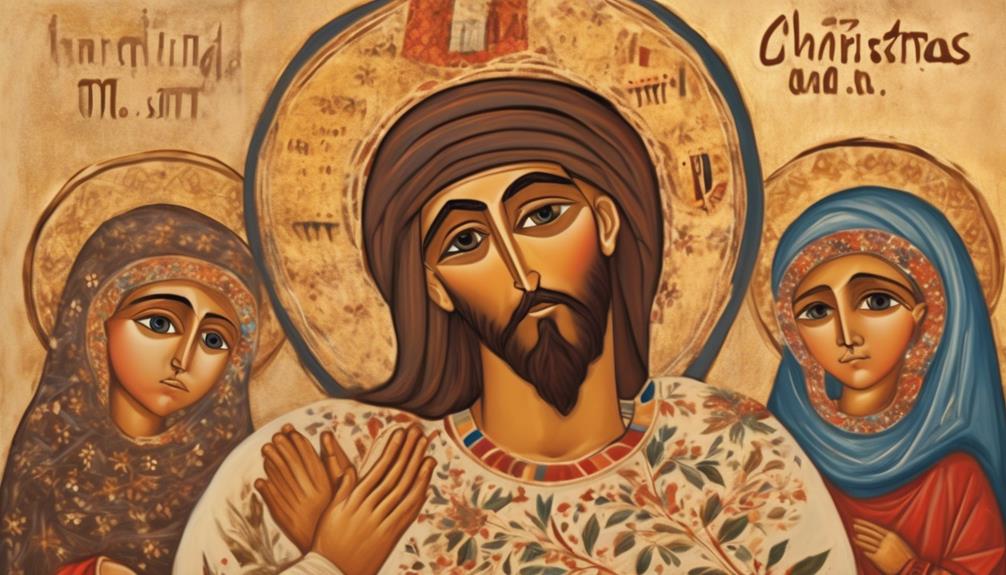
Coptic Christmas greetings carry immense cultural significance, fostering a sense of tradition and heritage within the community. These greetings also serve as a means to strengthen social connections and promote unity among Coptic Christians, creating a sense of belonging and shared identity.
Cultural Significance of Greetings
The tradition of exchanging Coptic Christmas greetings holds deep cultural significance within the Coptic community, fostering a sense of unity and connection during this important holiday. This practice reflects our cultural traditions and reinforces the bonds that tie us together as a community. The impact of Coptic Christmas greetings is substantial, as it serves as a reminder of our shared heritage and faith.
Here are some key points to consider:
- Preservation of Tradition: Greetings uphold our rich cultural heritage.
- Expression of Joy: Festive expressions convey our shared sense of joy and celebration.
- Community Bonding: Greetings strengthen our sense of community and togetherness.
- Cultural Identity: They reinforce our cultural identity and pride.
- Religious Significance: Greetings reflect our shared faith and devotion during this sacred time.
Exchanging Coptic Christmas greetings isn't just a formality; it's a meaningful expression of our shared values and beliefs.
Social Connections and Unity
Exchanging Christmas greetings within the Coptic community fosters a sense of social connection and unity, strengthening our bonds during this festive season.
These greetings serve as a foundation for social bonding, bringing us together in celebration of our shared traditions and beliefs.
When we engage in exchanging heartfelt greetings, we not only express our joy for the holiday but also affirm our belonging to the Coptic community.
This act of community engagement creates an atmosphere of warmth and togetherness, fostering a deep sense of unity among us.
By actively participating in this tradition, we reaffirm our connections to one another, building and reinforcing the strong social fabric that holds our community together.
As we extend and receive these greetings, we're reminded of the interconnectedness that defines us, enhancing the spirit of togetherness that characterizes Coptic Christmas.
Frequently Asked Questions
How Do Coptic Christians Typically Celebrate Christmas?
We typically celebrate Coptic Christmas with joyful gatherings and vibrant traditions. Our festive customs include attending church services, followed by festive meals with family and friends. We exchange gifts and enjoy traditional Coptic dishes.
The celebrations are marked by a sense of community and spiritual reflection. It's a time of togetherness and reverence, and we cherish the traditions that bring us closer to our faith and loved ones.
Are There Any Specific Foods or Dishes Associated With Coptic Christmas Celebrations?
During Coptic Christmas, our festive traditions include enjoying delicious foods like fata, a hearty dish made with rice, bread, and lamb, and kahk, sweet cookies filled with nuts and honey.
These Coptic Christmas foods are cherished by families and friends who gather to celebrate this special time. The flavors and aromas of these dishes embody the spirit of togetherness and joy during the holiday season.
What Are Some Traditional Coptic Christmas Decorations and Symbols?
For traditional decorations, we incorporate symbolic elements like the Nativity scene, known as 'The Crèche,' and images of the Holy Family.
We also adorn our homes with holly, mistletoe, and candles, symbolizing love, luck, and light.
These decorations bring warmth and joy to our celebrations, creating a festive and meaningful atmosphere for Coptic Christmas.
Is There a Specific Date or Time When Coptic Christmas Greetings Are Exchanged?
There isn't a specific date or time for exchanging Coptic Christmas greetings, as it varies depending on regional customs and individual preferences. The greetings hold immense cultural significance and are often exchanged during the Coptic Christmas Eve celebration on January 6th. However, regional variations exist, and some may exchange greetings on January 7th, the official Coptic Christmas Day.
The greetings reflect the warmth and joy of the festive season.
Are There Any Regional Variations in the Way Coptic Christmas Is Celebrated and Greeted?
In terms of regional variations and cultural differences, Coptic Christmas is celebrated and greeted in various ways.
Different regions may have unique traditions, foods, and customs surrounding the holiday.
These variations add richness and diversity to the overall celebration.
It's fascinating to see how people from different backgrounds come together to celebrate this special occasion, each bringing their own unique touch to the festivities.
How Do Coptic Christians Greet Each Other on Christmas?
During Christmas, Coptic Christians greet each other with the traditional Arabic greeting “Eid Milad Majid,” which means “Glorious Birth Feast.” Families gather for a festive meal, exchanging gifts, and decorating with unique Christmas trees, as they celebrate the joyous occasion.
Conclusion
In conclusion, the Coptic Christmas greeting is a cherished tradition that brings joy and unity to the community.
Like a warm embrace on a cold winter's day, the Coptic Christmas greeting spreads love and goodwill among family and friends, strengthening the bonds of faith and culture.
It's a simple yet powerful gesture that reflects the true spirit of the holiday season.
- About the Author
- Latest Posts
Introducing Ron, the home decor aficionado at ByRetreat, whose passion for creating beautiful and inviting spaces is at the heart of his work. With his deep knowledge of home decor and his innate sense of style, Ron brings a wealth of expertise and a keen eye for detail to the ByRetreat team.
Ron’s love for home decor goes beyond aesthetics; he understands that our surroundings play a significant role in our overall well-being and productivity. With this in mind, Ron is dedicated to transforming remote workspaces into havens of comfort, functionality, and beauty.
-

 Beginners Guides14 hours ago
Beginners Guides14 hours agoDecorating Your Living Room Wall
-

 Vetted5 minutes ago
Vetted5 minutes ago15 Best Sleepover Games to Keep the Fun Going All Night Long
-

 Vetted13 minutes ago
Vetted13 minutes ago15 Best Upholstered Headboards to Elevate Your Bedroom Decor
-

 Beginners Guides13 hours ago
Beginners Guides13 hours agoUnique Ways You Can Showcase Your Personality On The Living Room Wall
-

 Beginners Guides14 hours ago
Beginners Guides14 hours agoHow to Clean Up Your Home in Just 10 Minutes
-

 Beginners Guides13 hours ago
Beginners Guides13 hours agoHow to Keep Your Carpet From Getting Dirty This Weekend
-

 Vetted12 minutes ago
Vetted12 minutes ago14 Best Cleaners for Plexiglass to Keep Your Surfaces Crystal Clear
-

 Vetted14 hours ago
Vetted14 hours ago15 Best Kegerators for Keeping Your Beer Cold and Refreshing






















